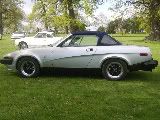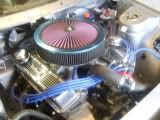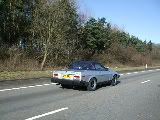Page 1 of 1
Cold starting issues
Posted: 05 Nov 2014 21:13
by mitchelltjohn
A lot of hesitation popping and missing when starting off at low revs.
Goes ok above 2000 revs. The popping sound coinciding with a miss is disconcerting.
Intend to fit to points, clean dist cap and check leads and plugs this weekend. Also will check float chambers to ensure not flooding.
Anything else I should to watch out for?
1979 FHC pageant blue
1981 DHC triton green
Posted: 05 Nov 2014 21:15
by mitchelltjohn
Also hesitation, missing and popping also occurs at low rev when accelerating from standstill when engine warm, though not as bad as when cold...
1979 FHC pageant blue
1981 DHC triton green
Posted: 05 Nov 2014 23:01
by Hasbeen
I had one that did that. It was flooding when stopped or Idling. Once traveling it used the fuel fast enough to stop flooding, which was just seeping past the needle & seat, due to high fuel pressure.
Had another make give similar problems to my dad, when the inline fuel filter was nearly full of water. Similar, but could also not handle full throttle at high revs.
Hasbeen
Posted: 06 Nov 2014 11:31
by mitchelltjohn
Thanks, could be flooding as the fuel gauge is dropping very quickly compared to normal.
Have had lots of problems with float chamber needles sticking due to dirty fuel. Changed fuel tank but still think things not perfect. I'm currently using a nylon in-line filter rather than a paper one. I'm thinking a paper one may have better filtration properties, also might restrict the flow a bit more - ???
1979 FHC pageant blue
1981 DHC triton green
Posted: 06 Nov 2014 12:05
by Hasbeen
The thing to do is beg borrow or steal a pressure gauge that will read down low. You need to measure the pressure, & make sure it is down at 2 PSI, or just under. Neither SU or Stromberg carbs will handle more than that reliably. If there is no other choice, you may even pay a shop that does such things, but it is no point wondering, you have to know.
I think you are probably right about paper filters working better, but they won't reduce the pressure to any extent until they are clogged with silt, & then they cut the flow entirely.
Hasbeen
Posted: 06 Nov 2014 22:35
by mitchelltjohn
Good input thanks.
If it is high fuel pressure just wondering what may have caused that recently? Can't think of anything that has changed...
1979 FHC pageant blue
1981 DHC triton green
Posted: 06 Nov 2014 22:55
by Hasbeen
Have you, or any one else touched the fuel pump? The pressure is controlled by the thickness of the spacers & or gaskets between the pump & the engine block. Remove a couple of gaskets, & the pressure goes up.
Needles & seats wear, & start to weep. When you turn the thing off, there is residual pressure in the fuel lines. A tired needle & seat will let this weep into one or both float bowls, while the car sits.
When driving this doesn't matter, as you are using fuel faster than it will weep. However it will give a high float level when stopped.
One of my 7s was fine when bought. I'll bet it had new needle & seats in both carbs. After a few thousand kilometers, some months later, it would be fine from cold, but would splutter & cough when started after a short [5 minutes to 60 minutes or so], stop. It had trouble getting much above idle. However once it got revs up, & was given a good rev in a lower gear, it would be fine, until turned off again.
I ultimately found it had 3.4 PSI fuel pressure. Once this was corrected with a spacer under the pump, it was fine.
Hasbeen
Posted: 07 Nov 2014 11:13
by mitchelltjohn
Thanks, you may be on to something - I fitted a new fuel pump and new needles whilst in process tracing my dirty fuel issue. Didn't know the gasket/spacer thickness had an effect on fuel pressure. I can try to dig out the gasket that came off the old pump and fit it to increasing spacing, or perhaps just fit the old pump and gasket back on, as don't think they where causing of any problem.
Will keep you posted
1979 FHC pageant blue
1981 DHC triton green
Posted: 07 Nov 2014 20:21
by Hasbeen
There are 2 different pumps available, identical except for the arm, one longer than the other. The short arm is the right pump for a 7, but in Oz, the importer tends to bring in the long arm pump, which suits more makes of cars.
In Oz it is marketed with a couple of hard plastic spacers in the box to go under it, depending on which type of car/engine it is fitted to. Pity they don't give adequate instructions in the box.
With that 7 I had problems with, I had to use a thick spacer, 0.25", plus 3 extra gaskets made from a corn flakes packet to get the pressure right, just under 2 PSI.
The pump has a variable wound spring that does the pumping. More compression, higher pressure. All the camshaft/leaver action does is compress this spring. The closer the pump is to the camshaft the more the spring is compressed, hence the packing adjusting the pump pressure.
Hasbeen
Posted: 08 Nov 2014 08:21
by dursleyman
Love that description of the pump/spacer thing, its the first time I have seen a proper explanation.
Thanks to Hasbeen.
PS is it worth getting something about this in the Workshop Manual?
Russ
1981 TR7 Sprint DHC
Dursley
UK
http://tr7russ.blogspot.co.uk/


Posted: 09 Nov 2014 07:32
by john 215
Hi,
Does it miss fire when put under load, ie. if you put your foot down in to higher a gear ?
What colour are the plugs ?
Would also check the low tension wire connection at the coil, they may look ok a first glance but seen a few that if you give them a wiggle they are only attached to the connector by a few strands.
Cheers John




LIVE LIFE A QUARTER OF A MILE AT A TIME!
1976 Speke FHC BEAUTY FITTED WITH OVERDRIVE GEARBOX
1979 3.5 FHC CURRENTLY GARDEN ART !
1982 2.0 DHC NOW A 4.6, BUILT NOT BROUGHT !!!!
Posted: 09 Nov 2014 21:42
by mitchelltjohn
Problem solved!
1. Fuel pump - great insight Hasbeen, this weekend I took off the fuel pump that I put on a few months ago to check. And indeed it had a longer lever so was creating a higher fuel pressure. Thankfully I kept the old pump which when I looked very closely (not obvious) had a shorter lever. I fitted it back and that sorted the flooding.
2. Idle was now very low, but that was sorted with new points, and clean is distributed cap and plugs (plugs were a red colour). Idle now perfect and running like a dream.
Any reason for red plug deposits?
Thanks for the all the very helpful guidance

1979 FHC pageant blue
1981 DHC triton green





